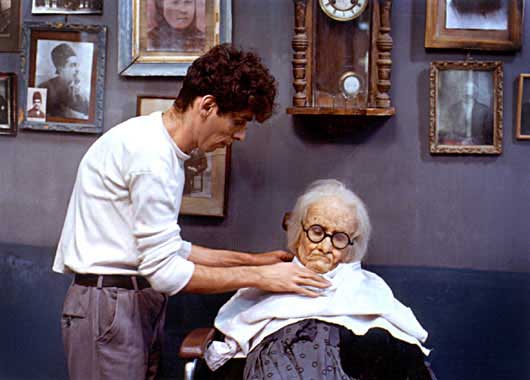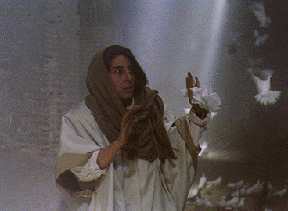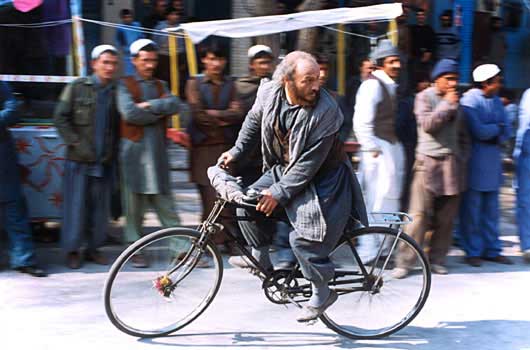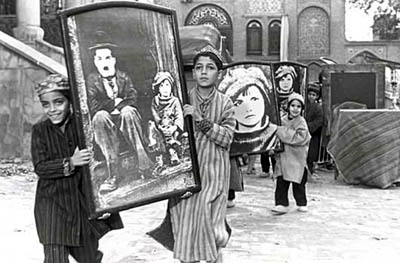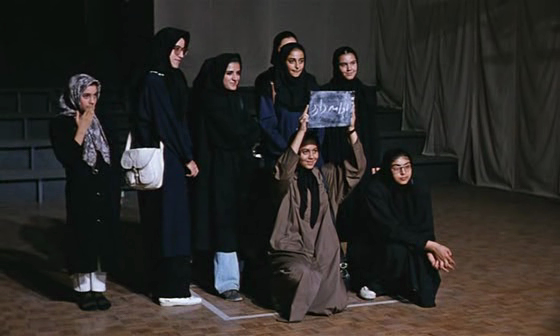From the Chicago Reader (April 11, 1997). I’ve suppressed the title/headline originally given to this piece, which I greatly regretted at the time, “Tortured Genius”. There are a few contributions of my own here that I also regret, but, for the record, I’ve decided to let this text stand. — J.R.
Films by Mohsen Makhmalbaf

It’s tempting but dangerous to approach artists from exotic cultures in terms of more familiar reference points — such as comparing Zhang Yimou’s Ju Dou to The Postman Always Rings Twice or reading Souleymane Cisse’s Brightness as if it were an African Star Wars, as some American and English critics have done. Yet to describe the styles and visions of the two major Iranian filmmakers of the 80s and 90s, Abbas Kiarostami and Mohsen Makhmalbaf, I’ve been exploring comparisons to Leo Tolstoy and Fyodor Dostoyevsky — a project obviously fraught with booby traps, but one that clarifies some of the important differences between these two major figures.
Last June the Film Center brought us seven features and nine short films by Kiarostami, and this month it’s showing ten features and one short documentary by Makhmalbaf, as well as three documentaries about him (one of them Kiarostami’s remarkable Close-up). This retrospective started last weekend with two of the most recent works, Makhmalbaf’s A Moment of Innocence and Houshang Golmakani’s Stardust-Stricken, Mohsen Makhmalbaf: A Portrait (both 1996). Half a dozen more films will show this week alone, and many of the best —The Peddler, Marriage of the Blessed, The Cyclist, and Close-up — will turn up the following week. It’s unfortunate that the films aren’t showing in chronological order — or in any logical order that I can discern — which makes the swerves in Makhmalbaf’s unpredictable career much harder to track. And regrettably absent are four features and a couple of recent short documentaries. (Two of the features, Nassoh’s Repentance [1982] and Two Sightless Eyes [1983], have never been subtitled; the third, The Nights of Zayandeh Roud [1991], is effectively a suppressed work; and the fourth, Gabbeh [1996], due to open commercially later this year, is missing because the U.S. distributor was unwilling to make it available for this retrospective.)
A key difference between these two writer-directors, which has only an oblique relevance to my Tolstoy-Dostoyevsky formula, is that Makhmalbaf is the most popular and respected filmmaker in Iran at the moment, despite his many run-ins with state censors, while Kiarostami is a hero principally elsewhere. Within Iranian society Kiarostami is widely regarded — and in some cases resented — as a self-serving pet of Western critics.
Though he came from a middle-class (albeit financially insecure) family, Dostoyevsky, whose first novel was entitled Poor Folk, called himself an “intellectual proletarian,” and an identification with society’s lower strata is clearly central to his work, as it is to Makhmalbaf’s. A central traumatic event that shaped Dostoyevsky’s future work was his arrest at age 27 for radical antigovernment activities (during the repressive reign of Czar Nicholas I) and his subsequent sentencing to death by a firing squad. This sentence was commuted at the last moment, and Dostoyevsky wound up with four years of hard labor in Siberia followed by four years of military service as an alternative sentence. But his belief that he was about to die left a permanent mark on his style and vision.
Something comparable happened to Makhmalbaf, a working-class fundamentalist and terrorist fighting the shah’s regime when he was arrested and tortured at the age of 17. Apparently it was only his youth that saved him from the firing squad; he wound up serving a five-year prison term that ended only with the 1979 revolution. Judging from a text by Makhmalbaf recently published in English that appears to be semiautobiographical, he fully expected to be killed during the early stages of his incarceration.

The incident that led to his arrest — Makhmalbaf stabbed a policeman with a knife — is the focus of A Moment of Innocence, his most recent feature. It’s one sign of his change over 22 years that the policeman he stabbed is invited to help re-create the event (as an unofficial, on-screen “codirector” who coaches the actor playing him) and show what he was going through at the time. A fictionalized version of Makhmalbaf’s arrest, torture, and stint in prison is the focus of Boycott (1985), and it’s no less telling that this film ends with its hero’s execution.
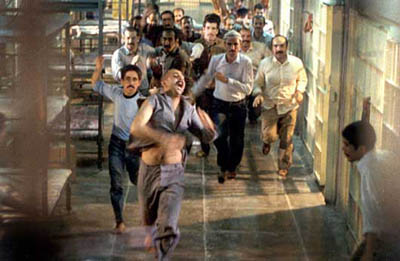
Comparing Kiarostami to Tolstoy involves a much looser set of analogies. For starters, Kiarostami hails from the upper middle class, not the cultured gentry, and his cautious distance from Islamic fundamentalism throughout his career has nothing in common with Tolstoy’s belated, fervent Christianity. Indeed, the physicality and serenity and cosmic overviews of both artists — in contrast to what might be termed the tormented psychological and spiritual underviews of Dostoyevsky and Makhmalbaf — may constitute the sum of their shared traits. They’re both masters of framing landscapes and vistas in contemplative long shots, while Makhmalbaf and Dostoyevsky are expressionist sketch artists exposing the cramped and conflicted interiors of their own brains in staccato flashes of lightning. Otherwise Tolstoy and Kiarostami seem to share common ground mainly in contrast with the nervous, twitchy, and hysterical styles of Dostoyevsky and Makhmalbaf and the comparable behavior of many of their characters.
When I took a course devoted to the two Russian authors in college the class was split between partisans of each; I can’t recall anyone apart from the teacher who expressed equal fidelity to both. I belonged to the Tolstoy camp, and if I reread both writers today I’d probably feel the same. I also feel closer to Kiarostami than to Makhmalbaf, maybe because my background is closer to his. But much as I suspect that Dostoyevsky has more to say about Russian culture than a universalist like Tolstoy — which can help when it comes to understanding a filmmaker like Andrei Tarkovsky, for instance — I’m fairly certain that it’s Makhmalbaf, not Kiarostami, who has the most to teach me about Iranian culture, particularly over the past quarter of a century.
Apart from growing up poor, Makhmalbaf was an unwanted child, as we learn from Stardust-Stricken; he was essentially raised by his grandmother, whom he later had to support and care for. (This experience inspired the middle episode of his three-part feature The Peddler, about a scatterbrained, spastic, and persecuted Jerry Lewis type whose life is devoted to caring for his aged and senile mother.) After he emerged from prison he returned to some form of political activism for a short spell, then helped establish a group of artists known as the Islamic Propagation Organization and became a prolific writer of plays, essays, short stories, and eventually screenplays. One early monograph — a good indication of how far he’s traveled ideologically — propounded a fundamentalist argument against women appearing onstage. His first screenplay to be realized (by someone else) was The Explanation (1981), and he directed his first feature the following year. Reportedly neither of his first two features — both marked by didactic Islamic propaganda — had much of a public impact.

I’m told that Makhmalbaf now dislikes Fleeing From Evil to God (1984) and Boycott, his third and fourth features (showing on April 27), and agreed to include them in this touring retrospective only after recutting them. The first [see poster above] is by all counts the worst of his films I’ve seen, bad on just about every level — acting, mise en scene, script, and overall conception. But its evident sincerity combined with its naivete is undeniably fascinating, because I’ve never seen anything else like it; its rough American equivalent would be a painting of Jesus in the wilderness executed by an illiterate farmer. The only Makhmalbaf movie I’ve seen in ‘Scope, it follows five nameless religious men, all dressed like monks, to a desert island as they flee from the devil’s temptations. The opening music calls to mind a spaghetti western, but very little happens in the film; the “action” consists mainly of metaphysical speculation spelled out in allegorical terms, not any sort of struggle with evil or Satan in the real world.
No two Makhmalbaf films are alike. Moving from film to film, you see a mercurial, troubled intelligence constantly seizing upon new stylistic influences, often seeming at odds with itself within individual features. But it’s still a shock to pass from a strained, amateur exercise like Fleeing From Evil to God to the skillful and frenetic Boycott, which abounds in Hollywood-style action sequences (including a shoot-out, a prison escape, and an adroit car chase), goofy and upsetting subjective moments (such as the hero’s nightmare of ants devouring the flesh on his face and animated ants in a later sequence), and apparently unmotivated freeze-frames tossed into the middle of a prison riot. The film clearly charts Makhmalbaf’s disillusionment with politics: “I used to fight because I existed,” the protagonist says in an early scene, after his arrest. “Now I no longer exist.” (Much later, he dryly notes that “imperialism and socialism are the same to a corpse” to a communist fellow prisoner bent on turning him into a Marxist martyr.) It also shows a growing commitment to popular filmmaking; as a fundamentalist youth, Makhmalbaf says in an interview in Stardust-Stricken, he was so opposed to cinema that he once refused to speak to his grandmother for several days after she went to the movies. (Apparently he now dislikes Boycott for its commercialism and has the same objection to The Actor, made eight years later, a box-office hit in Iran.)
In the April issue of Sight and Sound, Hadani Ditmars reports Makhmalbaf saying that “the best Iranian films came from the 1985-90 period, when censorship was at a low ebb.” Considering the output of both Makhmalbaf and Kiarostami during these six years, it’s a thesis well worth considering. During this stretch Kiarostami made The First Graders, Where Is My Friend’s Home?, Homework, and Close-up (he made his masterpiece Life and Nothing More… in 1992); Makhmalbaf made Boycott, The Peddler (1986), The Cyclist (1987), Marriage of the Blessed (1988), Time of Love (1990), and The Nights of Zayandeh Roud. The last two pictures were promptly banned, and Time of Love — a three-part theme-and-variations about adultery shot in Turkey with Turkish actors — seems a relatively minor work (albeit a thoughtful and provocative one). But the preceding three pictures may well represent Makhmalbaf’s most important achievements to date.
All three are tortured, lyrical arias about human suffering in contemporary Iran that attack social problems — urban squalor, social cruelty, and crime in the three sketches of The Peddler; commercial exploitation in The Cyclist; the nervous condition of a traumatized veteran of the Iran-Iraq war in Marriage of the Blessed — with an unrelenting hallucinatory fury. All three pictures, along with Boycott, are somewhat out of control, but as with Dostoyevsky in novels like The Idiot, it’s when Makhmalbaf is most out of control that he seems to cover the widest emotional and poetic range of material in the everyday world that surrounds him. Rather like Martin Scorsese wrestling with the demons and contradictions of his childhood Catholicism, Makhmalbaf seems to be fighting new versions of the same battle between his Islamic background and his skeptical, evolving intelligence in every project, but in these three films the scope of his ambition and engagement appears to be the widest.
In a recent interview Makhmalbaf notes that “a major difference between Iranian and Western cinema is that in the West, the evolution of cinema began with paintings, then photography…it was a progression through image….But in the East, our tradition of the Persian miniature did not really affect our cinema. At the beginning of the Islamic era, paintings and drawings were discouraged. So our tradition of image is not as old as our tradition of poetry… [and] we went straight from narrative to cinema….Our story-telling tradition is very poetic.”
How does Makhmalbaf’s visual style reflect this alternative tradition? Largely, it seems, through its eclectic editing and framing, including frequent recourse to what Western viewers regard as eccentric camera angles — shots where the camera is lower or higher than we’d expect or where it frames the action obliquely, sometimes through windows or doors or with various obstructions cluttering the foreground (such as prison bars in Boycott). These angles are especially apparent in Boycott, The Peddler, The Cyclist, Marriage of the Blessed, and The Actor, and what seems most disorienting about them is their seeming lack of motivation. In contrast to the Western visual tradition, which has the legacy of painting and still photography lurking behind every shot we perceive as “normal,” Makhmalbaf’s choices of camera placement seem wider and more arbitrary — especially when he’s filming the same action from a succession of vantage points, as he does throughout The Cyclist — because the meanings of these angles are less coded, even when they carry the clear influence of Western cinema. This gives his scattershot technique a freshness combined with an overall sense of chaos: like a restlessly shifting insomniac, a typical montage leaps around a given subject with desperate abandon, as if looking for and never finding a proper resting place. This might be termed the Makhmalbaf twitch effect, and it’s central to the nervous energy of his movies.
Turning to the cinema as a subject in his next three features, Makhmalbaf goes through a significant series of gear changes. Once Upon a Time, Cinema (1992), a comic fantasy about the birth of Iranian cinema, most of it in black and white, seems designed as a peace offering to the Iranian government, which banned his two previous features. It isn’t devoid of provocation, particularly when it comes to handling the shah’s harem — Makhmalbaf is invariably something of a troublemaker even when he’s mending bridges — but it’s mainly a work of bits and pieces, never more so than when it’s summing up the history of Iranian cinema in the sentimental closing montage (which ends with an emblematic landscape from Kiarostami’s Where Is My Friend’s Home?). Missing from this montage is any scrap of what I regard as the greatest of all Iranian films, Forugh Farrokhzad’s 1962 short documentary about a leper colony, The House Is Black — a film Makhmalbaf caught up with only in 1995 at the Locarno film festival. Farrokhzad’s radical poetic humanism makes mincemeat of the first episode of The Peddler, a horrified look at the government’s treatment of retarded children — an episode with a chamber-of-horrors approach that, for all its power, seems cheap and voyeuristic in comparison.
Images From the Qajar Dynasty (1992) is a short documentary about the shah’s palace that figures in Once Upon a Time, Cinema (both films are showing together at the Film Center this Sunday). Dedicated to French filmmaker Albert Lamorisse — the Oscar-winning director of The Red Balloon (1956) who died while shooting a documentary about Iran–it begins with a helicopter shot in homage to his work, before moving on to glancing echoes of Alain Resnais and, in the use of sound effects to accompany paintings, Sergei Paradjanov (a major inspiration in Makhmalbaf’s subsequent Gabbeh).
The Actor (1993), a semitragic satire about contemporary Iran and its media, makes several references to Once Upon a Time, Cinema (using some of the same actors, making allusions to Charlie Chaplin). It was made around the time that Makhmalbaf’s first wife burned to death in a domestic accident, and there may be some bitter echoes of his marriage in the grotesque, strident quarrels in this film between a movie actor and his infertile wife–which might account in part for Makhmalbaf’s recent antipathy toward the film. (He subsequently married his late wife’s sister and has children from both marriages; as one indication of the degree to which he’s still affected by his impoverished roots, I’ve heard that he refuses to allow any of his children to own more than one set of shoes at a time — a rule he also adheres to.) As a modernist work that’s also an attack on modernity, The Actor seems divided against itself in a manner that’s characteristically Makhmalbafian — and bad tempered in a way that periodically makes it seem like a rebuttal to the good-natured comedy of his previous film.
As an indication of Makhmalbaf’s popularity in Iran by the early 90s, his casting call for Salaam Cinema (1994) yielded about 3,000 applicants — a virtual riot that we see at the beginning of the film, a documentary chronicling some of the auditions. Here Makhmalbaf’s role as provocateur is only incidentally aimed at the audience; it’s mainly directed at the hapless applicants, whom he mercilessly bullies, taunts, and plays with — all but parodying some of the psychological tortures he underwent as a youth and depicted in Boycott. (As if to drive home this disturbing parallel, he shows at one point his manipulations of a former political prisoner who’s auditioning along with his two sons.) It’s clear that Makhmalbaf’s sadistic and authoritarian mind games — such as pitting friends and relatives against one another (“The one that cries the fastest knows the most about love”) — carry a didactic message about the social power of cinema. But whether on this occasion it’s a useful lesson or a callous excuse for exploitation is a question he seems willing to leave open — refusing to respond when one brutalized teenage girl throws one of his testy questions back at him (“Would you rather be an artist or a humane person?”) or claiming a bit later, without much conviction, that “it’s the camera that’s so cruel.”
In more ways than one, these sequences call to mind the tears of a young schoolboy frightened by the documentary camera crew filming him in Kiarostami’s Homework, raising the whole thorny issue of how much intimidation by cinema and the exposure of that intimidation can justify each other. Determining to what extent Kiarostami’s kindness or Makhmalbaf’s cruelty is real has a lot to do with how one approaches the work of either filmmaker — though this doesn’t mean the answer to one question should determine the answer to the other. That both filmmakers are swimming in the same treacherous waters — trying to discover what truth and honesty mean within a repressive society that also may contain kinds of wisdom, beauty, and humanity missing from our own, and trying to express those meanings in universal as well as local terms–suggests that we should attend to both of them, not choose between them.
Even if one concludes that Kiarostami is merely more adept in cloaking his sadistic use of power than Makhmalbaf — the interpretation of some Iranian viewers — the problem posed by both filmmakers about their authoritarian roles as filmmakers in an authoritarian society remains the same. In films as diverse as Homework, Close-up, and Life and Nothing More…, Salaam Cinema, The Actor, and A Moment of Innocence, both artists are either literally or figuratively inserting themselves as characters in their own fictions and documentaries and charting their interactions with working-class Iranian society — an ongoing project of self-interrogation that has few counterparts in Western cinema (with the partial exception of Godard’s experiments with French television in the 70s).
If Makhmalbaf remains the more troubling figure, especially for Western viewers, there’s little doubt that he’s also the more exposed — that’s what the Makhmalbaf twitch effect conveys to us, for better and for worse. Each of his films proposes a different kind of laboratory to test the pertinence and persistence of Islam in the modern world, overheated experiments in which he uses his own tormented soul.

